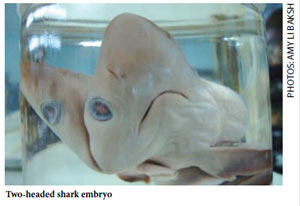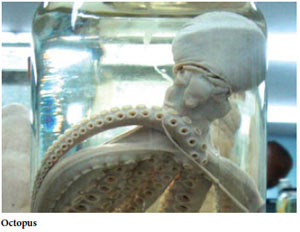 |
 |
 |
|
August 2010
|
The Old Curiosity MuseumBy Vaneisa Baksh “It is truly diverse, with some oddities thrown in: heart of a whale, paw of an elephant, backbone of a buffalo, skull of a child, you get the drift.”It’s a curiosity; that’s what it is. Innocuous along a grey corridor of classrooms… FSA 114, FSA 113, Biosystematic Laboratory L53… it’s hard to imagine that just beyond the door with the square glass pane reposes a 5000-year-old Banwari skeleton.
The Zoology Museum is actually divided between two rooms. The first, opposite L53, has a formidable array of shelves where jars huddle–The Spirit Collection. Tightly packed in here are around 2,500 jars, mostly filled with fish of both marine and freshwater species. It’s teeming with preserved marine life (some in The Dried Collection): crustaceans, molluscs, sponges, corals, thousands of shells and, not for the squeamish (whose name I won’t call), a fair number of reptiles, amphibians and bats. Many of the exhibits have been brought in by students, researchers, and curious adventurers, making it an open, growing collection–pretty much as it has been since 1920 when it started. Next door is the Land Arthropod Room, which is all insects and land arthropods (jointed-leg creatures): scorpions, centipedes (the largest in the world is a Trinidadian), spiders, millipedes, and the like, about 15,000 specimens. The majority of them are pinned in drawers and cabinets, most are from Trinidad and Tobago, and the rest are mainly from within the Caribbean. The butterflies and moths are gorgeous, farmers must see the bugs, and the beetles clearly belong in sci-fi movies, some so ornate and brilliantly coloured, they lie like iridescent jewels. Of course there are the social insects: ants, bees, wasps–darlings of the Life Sciences Department–and the pests: mosquitoes, houseflies, cockroaches (enormous ones!). There is also a Geology Collection, full of minerals, rocks and fossils of all sorts, and the Anthropology Collection which holds the Banwari skeleton found in San Francique in 1971. It is truly diverse, with some oddities thrown in: heart of a whale, paw of an elephant, backbone of a buffalo, skull of a child, you get the drift. The Museum has benefited from donations by individuals and organisations. In the late 1940s, for instance, the collection of butterflies and moths belonging to Sir Norman Lamont, a Scottish baronet and estate owner in Trinidad (site of the River Estate Museum and Water Wheel in Diego Martin), was donated to the Museum. Sir Norman had served on the Legislative Council of Trinidad and Tobago from 1921 to 1945, and was a Governor of the Imperial College of Tropical Agriculture (ICTA), the forerunner to The UWI. His interest in entomology led to him producing a Catalogue of Trinidad Moths in 1927. (At 79, he was gored to death by a bull on his estate.)
The other major collection has been assembled under a different premise. At the Caribbean Epidemiology Centre (CAREC), specimens were gathered on account of their epidemiological relevance – insects, mammals, reptiles, even an experimental mosquito colony – anything that could further the work initially begun by the Trinidad Regional Virus Laboratory, which existed from 1953 until it was absorbed into CAREC in 1975. The collections of all three are generally kept quietly, partly because their specialised exhibits are of interest mainly to a select group; but space is a big factor in their inability to accommodate large groups or to advertise their wares on a grander scale. The freshly appointed curator of the Zoology Museum, Mike Rutherford, wants to change that. Since he came to St. Augustine just over six months ago to take up the position, he has been busy stock-taking, cataloguing and working out strategies to build its profile and garner corporate sponsorship for its future. Acknowledging that it is a tall order, Rutherford envisions a Bio-Diversity Centre, large enough and wise enough to house various units on the campus which contribute to bio-diversity. The National Herbarium and the Cocoa Research Unit (custodian of one of two world cacao genebanks) would be natural cohabitants. His wish list includes a purpose-built museum with space for storage and display, a comprehensive database, and resources for staff, conservators, tour guides, and technology. It would be costly, but an investment in the country at many levels (corporations should find that appealing). “It’s readily accepted that historical artefacts are housed in national museums, but you have to look at your natural history in the same way,” he says. “The zoological and botanical specimens should all be valued in the same way. The only way to get people to care more for their environment is to let them be informed about it.” And the museum is living proof of that. |

 Like a buried treasure chest, the Zoology Museum at UWI’s St. Augustine Campus contains layers of riches–the collection reflects the scandalous bio-diversity of the country, its range is unparalleled, it is a trove for researchers (it provides animal IDs) and simply, it is just full of fascinating stuff.
Like a buried treasure chest, the Zoology Museum at UWI’s St. Augustine Campus contains layers of riches–the collection reflects the scandalous bio-diversity of the country, its range is unparalleled, it is a trove for researchers (it provides animal IDs) and simply, it is just full of fascinating stuff. Apart from The UWI, there are two other substantial collections in the country. CAB International, an organisation celebrating its centenary this year, houses approximately 15,000-20,000 specimens. According to its website, CABI began in 1910 as an entomological committee, but now offers service in agricultural information, pest identification and biological control. The Centre’s Administrator, Anne De Gazon, explained that the small office, tucked away on Gordon Street in St Augustine, cannot accommodate masses of visitors but students and researchers are welcomed to use the facilities as long as they call ahead.
Apart from The UWI, there are two other substantial collections in the country. CAB International, an organisation celebrating its centenary this year, houses approximately 15,000-20,000 specimens. According to its website, CABI began in 1910 as an entomological committee, but now offers service in agricultural information, pest identification and biological control. The Centre’s Administrator, Anne De Gazon, explained that the small office, tucked away on Gordon Street in St Augustine, cannot accommodate masses of visitors but students and researchers are welcomed to use the facilities as long as they call ahead.